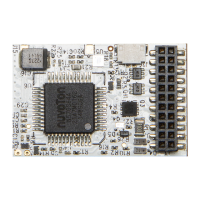
Do you have a question about the Hornby HM DCC HM7000 Series and is the answer not in the manual?
| Brand | Hornby |
|---|---|
| Model | HM DCC HM7000 Series |
| Category | Media Converter |
| Language | English |
Covers the initial steps after unpacking a sound decoder and basic setup procedures.
Instructions for downloading and installing the required Hornby HM7000 mobile application.
Step-by-step guide on configuring the app and linking your new decoder.
Setting the locomotive's address and selecting control modes like DCC or Bluetooth.
Explains the manual's structure, scope, and naming conventions used throughout.
Defines hardware terms like HFO/AUX and the OTA update process.
Details the operational modes available for HM7000 decoders.
Lists recommended Hornby power supplies for HM7000 decoders.
Advises on the risks and considerations of using non-standard power sources.
Introduces the various connection types available across the HM7000 decoder range.
Details the specifications and pinout for the 21-pin sound decoder.
Outlines features not supported or requiring different procedures for non-sound decoders.
Provides a general summary of function ranges for sound and non-sound decoders.
Details the specific function ranges for sound and non-sound decoder types.
Explains how to perform firmware updates wirelessly via the mobile app.
Guides on installing and updating sound profiles for specific locomotives.
Details the internal firmware structure including LDROM, APROM, and SPIROM.
Configuration for basic locomotive address and motor start voltage.
Settings to control the locomotive's acceleration and deceleration behavior.
Sets the motor voltage level for the maximum speed step.
Provides information on the manufacturer's firmware version number.
Contains manufacturer ID and functionality for resetting the decoder.
Details on using HFOs for controlling locomotive lighting systems.
Explains the use of logic-level outputs for controlling other features.
Details special function mapping for sound and non-sound decoders.
Explains how to configure and activate shunting mode.
Sets all sound volumes to a common level using a global CV.
Adjusts volumes for Steam, Diesel, and Electric locomotive sound engines.
Configuration details for 3-notch and 4-notch diesel engine sound playback.
Details the different rev levels (notches) for electric locomotive sounds.
Explains the diesel and electric engine parts within electro-diesel locomotives.
Details the simulation of steam locomotive wheel chuffing sounds.
Explains the fundamental concepts of Configuration Variables and binary data.
Defines short and long addresses and how they are stored in decoders.
Details the storage methods for short and long decoder addresses.
Explains the purpose and function of AUX outputs and HFOs.
Provides details on HFO types, voltage, current capabilities, and limitations.
Explains the concept and waveform of Asymmetrical DCC Control.
Explains the importance and process of tuning locomotive motor control.
Describes the relationship between speed steps and motor voltage.
Details the default 3-point speed curve configuration.
Explains the user-definable speed curve using multiple CV values.
Outlines the stages and methods for tuning motor control algorithms.
Step-by-step guide for performing the auto-calibration process.
Lists the CVs used for manual PID tuning of motor control.
Explains the smart charging feature for the Power Bank.
Details operational, electrical, and physical specs for sound decoders.
Details operational, electrical, and physical specs for non-sound decoders.